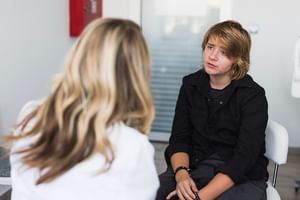How to talk with youth about gun violence
Firearm violence is an unfortunate part of kids' lives today. It's more common in some communities than others, but children and teens throughout the United States participate in active shooter drills at school and hear about community tragedies on the news.
Firearm violence takes a toll not only on kids’ physical safety but also impacts their mental health for years to come. Kids who live in communities with high rates of firearm violence may live with the constant fear that it will affect them or someone they love.
Health care professionals have a role to play in keeping children and teens safe from firearm violence and helping them process related stress and anxiety. Here’s how to talk with children and teens about firearm violence in an age-appropriate way. (We have a separate guide with tips for talking with their parents.)
When to start the conversation
When young children visit the doctor, a parent or caregiver is usually in the room throughout the appointment. But as patients approach their teen years, a health care professional will begin to have private one-on-one conversations with them in addition to talking with their parents.
During these conversations, you may ask teen patients questions about their physical and mental health. This could include whether they follow recommended safety practices such as bike helmets, seat belts, and online media. The patient may also have questions, or they may express concerns about firearm violence in their community and beyond.
How to start the conversation
Tailor your approach based on what you know about the patient. As you discuss safety issues teens often face, including smoking and vaping, substance use, and impaired driving, you have an opportunity to raise the topic of access to firearms.
Start the conversation by asking for permission.
Asking for the patient’s permission builds trust and allows them to steer the conversation.
“I like to ask my patients a few common questions about household safety. Is it OK with you if I do that now?”
“Some of my patients have guns at home, so I also like to ask patients if guns are part of their life. Is there a gun at home or one you could easily access?
“It sounds like you understand the risks associated with firearms, and that’s great. I’d like to bring your parent(s)/caregiver(s) in and talk with them about secure firearm storage. Could I do that now, or do you have any other questions for me?”
How to talk about unintentional shootings

To add context to the conversation, it may be helpful to share facts about firearm violence in an age-appropriate way or check if the patient understands the risks associated with firearms.
When you talk openly with young patients, you remind them that they have a role to play in their own health and safety.
“If you found a gun at a friend’s house, what do you think you’d do? Don’t touch it, tell a trusted adult right away."
“If a friend told you they had access to a gun, what do you think you’d do? If you’re not sure, I can share some ideas on what to say. As soon as you can, tell a trusted adult and encourage your friend to tell a trusted adult. Discourage your friend from touching or using the gun by doing something else you enjoy, like video games or going outside.“
“Kids are injured or killed every day from unintentional shootings. Even if you find a gun that looks like a toy, don’t touch it and tell a trusted adult right away.”
How to talk about intentional shootings
Young people may hear about mass shootings and gun homicides on the news and worry that something like that could happen where they live.
“If you’re ever feeling stressed about a shooting or anything else, do you have someone you can talk to? What helps you process your emotions when you’re feeling that way?”
“It can be scary and overwhelming to hear about shootings, but we can keep our community safer by looking out for each other. If you’re ever worried that someone in your life might do something violent, share your concerns with a trusted adult.”
How to talk about firearm suicide
Checking in with young patients about their mental health is another opportunity to discuss firearm violence.
“Sometimes people get so sad or are struggling so much that they think about hurting themselves. Have you ever felt this way?”
“If you ever find yourself struggling, remember that you can reach out to a trusted adult. No matter how bad things may seem, there are resources and help available to you.”
“When someone is in crisis, they need time to think things over and get professional help. If someone you know has access to a gun and they are struggling, it’s important to reach out to a trusted adult so they can’t hurt themselves or anyone else.”
Encourage kids to lead the conversation

Young patients may have unique fears and concerns about gun violence. Instead of trying to anticipate what they are thinking, let them know you are there to listen and that you want to help them stay safe.
“Everything we talk about here is confidential. The only exception is if I’m worried you might harm yourself or someone else. You can ask me anything.”
“Do you have any questions, or is there anything you’d like to talk about?”
“Have you ever felt unsafe at home, at school, or anywhere else? If you’re comfortable talking about it, could you tell me what happened?”
After the chat
- If a child or teen mentions that there are unsecured firearms in their home, start a conversation with their parents about how securing their guns can help keep their child safe. Use this guide to get started.
Tips for having productive conversations
- Focus on finding common ground with young patients. Let them know you want to help them live a safe, healthy life.
- If a patient isn’t interested in discussing firearm injury prevention with you, respect that decision. Focus on building trust, and revisit the topic during a future visit.
- Acknowledge the conversation may be different based on the age of the patient. Use age-appropriate language and real-life examples. If a parent is there, still acknowledge bodily autonomy of the patient.
- Stay up to date on the latest screening tools and recommendations to help prevent firearm-related injuries among youth. Visit our resources page for academic courses, podcasts, webinars, and more.
The information provided on this site is for general education purposes. Consult your health care professional for specific advice. Call or text 988 if you or a loved one is in crisis.
Start a conversation
The resources available on our site are provided for informational purposes only and do not necessarily reflect the views or positions of the American Medical Association (AMA) or the Advertising Council, Inc.
